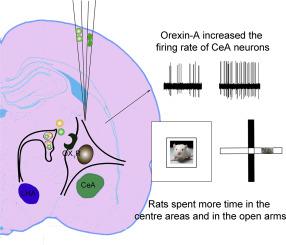当前位置:
X-MOL 学术
›
Neuropeptides
›
论文详情
Our official English website, www.x-mol.net, welcomes your
feedback! (Note: you will need to create a separate account there.)
Involvement of orexin-A in the regulation of neuronal activity and emotional behaviors in central amygdala in rats
Neuropeptides ( IF 2.5 ) Pub Date : 2020-04-01 , DOI: 10.1016/j.npep.2020.102019 Yi-Peng Pan 1 , Cui Liu 1 , Mei-Fang Liu 1 , Ying Wang 1 , Kang Bian 1 , Yan Xue 1 , Lei Chen 1
Neuropeptides ( IF 2.5 ) Pub Date : 2020-04-01 , DOI: 10.1016/j.npep.2020.102019 Yi-Peng Pan 1 , Cui Liu 1 , Mei-Fang Liu 1 , Ying Wang 1 , Kang Bian 1 , Yan Xue 1 , Lei Chen 1
Affiliation

|
The amygdala is a complex structure involved in the regulation of emotional behaviors including fear and anxiety. The central amygdala is the main output of the amygdala and plays an important role in emotional processing. Recent studies indicate that orexin, a kind of neuropeptides responsible for maintaining wakefulness, is also associated with emotion-related behaviors, such as depression- and anxiety-like behaviors. Central amygdala receives orexinergic fibers originating from the lateral hypothalamus and expresses OX1 receptors in rats. To test the electrophysiological and behavioral effects of orexins in the central amygdala, single unit in vivo extracellular recordings, open field and elevated plus maze tests were performed in rats. Micro-pressure administration of orexin-A (0.01 mmol/L) increased the firing rate in 18 out of the 31 central amygdala neurons, while the other 13 neurons were not excited by orexin-A. The excitatory effects of orexin-A on central amygdala neurons were mainly mediated by OX1 receptors rather than OX2 receptors. Orexin-B (0.01 mmol/L) did not change the firing activity in all recorded central amygdala neurons. Selectively blocking OX1 receptors by SB-334867 (0.01 mmol/L) significantly decreased the spontaneous firing rate in 14 out of the 33 central amygdala neurons, leaving the remaining 19 neurons were not affected. However, blocking OX2 receptors by TCS-OX2-29 (0.01 mmol/L) did not change the firing activity. Finally, both open field test and elevated plus maze test showed that bilateral microinjection of orexin-A into the central amygdala induced significantly anxiolytic-like behaviors. The specific OX1 receptor antagonist tended to produce opposite effects although there was no statistical difference. The present electrophysiological and behavioral studies suggested that orexin-A participates in anxiety-like behaviors by modulating the spontaneous firing activity of central amygdala neurons.
中文翻译:

orexin-A参与调节大鼠中央杏仁核神经元活动和情绪行为
杏仁核是一个复杂的结构,参与调节包括恐惧和焦虑在内的情绪行为。中央杏仁核是杏仁核的主要输出,在情绪处理中起重要作用。最近的研究表明,食欲素(一种负责维持清醒的神经肽)也与情绪相关行为有关,例如抑郁和焦虑样行为。中央杏仁核接收源自外侧下丘脑的食欲素纤维,并在大鼠中表达 OX1 受体。为了测试食欲素在中央杏仁核中的电生理和行为影响,在大鼠中进行了单单元体内细胞外记录、开放场和高架十字迷宫试验。食欲素-A (0. 01 mmol/L) 增加了 31 个中央杏仁核神经元中 18 个的放电率,而其他 13 个神经元没有被orexin-A 兴奋。orexin-A 对中央杏仁核神经元的兴奋作用主要由 OX1 受体而不是 OX2 受体介导。Orexin-B (0.01 mmol/L) 没有改变所有记录的中央杏仁核神经元的放电活动。SB-334867 (0.01 mmol/L) 选择性阻断 OX1 受体可显着降低 33 个中央杏仁核神经元中 14 个的自发放电率,而其余 19 个神经元不受影响。然而,通过 TCS-OX2-29 (0.01 mmol/L) 阻断 OX2 受体并没有改变放电活性。最后,露天试验和高架十字迷宫试验均表明,将orexin-A 双侧显微注射到中央杏仁核中可诱导显着的抗焦虑样行为。尽管没有统计学差异,但特定的 OX1 受体拮抗剂往往会产生相反的效果。目前的电生理和行为研究表明,orexin-A 通过调节中央杏仁核神经元的自发放电活动参与焦虑样行为。
更新日期:2020-04-01
中文翻译:

orexin-A参与调节大鼠中央杏仁核神经元活动和情绪行为
杏仁核是一个复杂的结构,参与调节包括恐惧和焦虑在内的情绪行为。中央杏仁核是杏仁核的主要输出,在情绪处理中起重要作用。最近的研究表明,食欲素(一种负责维持清醒的神经肽)也与情绪相关行为有关,例如抑郁和焦虑样行为。中央杏仁核接收源自外侧下丘脑的食欲素纤维,并在大鼠中表达 OX1 受体。为了测试食欲素在中央杏仁核中的电生理和行为影响,在大鼠中进行了单单元体内细胞外记录、开放场和高架十字迷宫试验。食欲素-A (0. 01 mmol/L) 增加了 31 个中央杏仁核神经元中 18 个的放电率,而其他 13 个神经元没有被orexin-A 兴奋。orexin-A 对中央杏仁核神经元的兴奋作用主要由 OX1 受体而不是 OX2 受体介导。Orexin-B (0.01 mmol/L) 没有改变所有记录的中央杏仁核神经元的放电活动。SB-334867 (0.01 mmol/L) 选择性阻断 OX1 受体可显着降低 33 个中央杏仁核神经元中 14 个的自发放电率,而其余 19 个神经元不受影响。然而,通过 TCS-OX2-29 (0.01 mmol/L) 阻断 OX2 受体并没有改变放电活性。最后,露天试验和高架十字迷宫试验均表明,将orexin-A 双侧显微注射到中央杏仁核中可诱导显着的抗焦虑样行为。尽管没有统计学差异,但特定的 OX1 受体拮抗剂往往会产生相反的效果。目前的电生理和行为研究表明,orexin-A 通过调节中央杏仁核神经元的自发放电活动参与焦虑样行为。











































 京公网安备 11010802027423号
京公网安备 11010802027423号